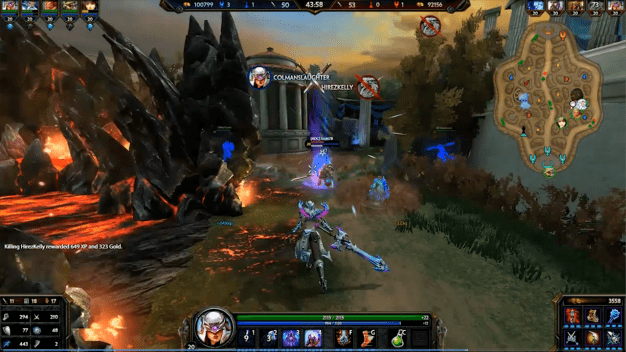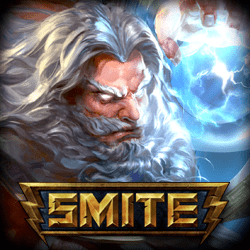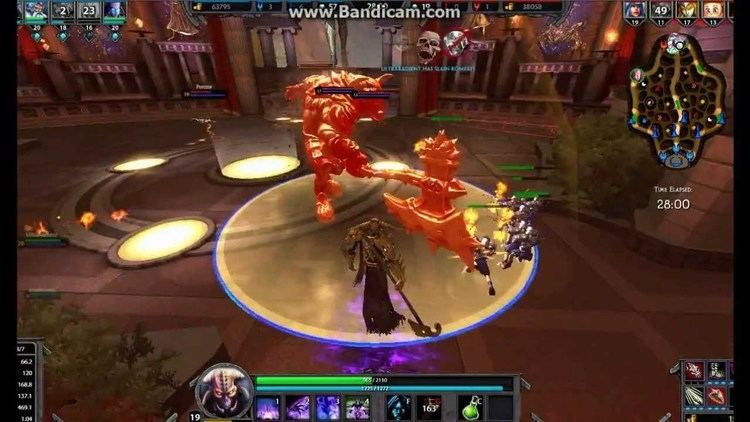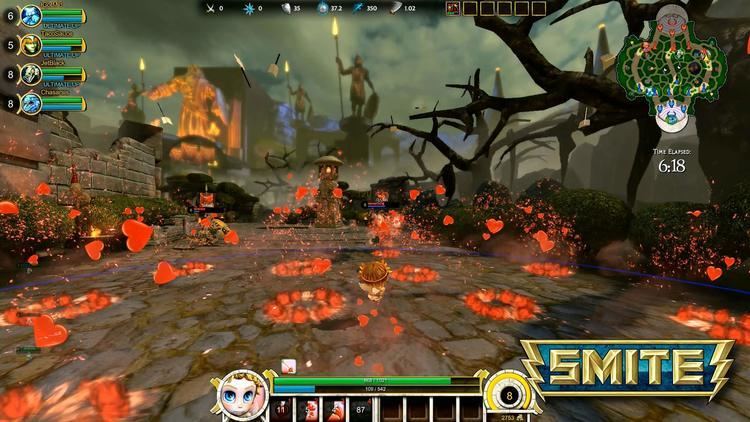8.6 /10 1 Votes8.6
Initial release date 25 March 2014 | 8.5/10 IGN Mode(s) Multiplayer | |||||||||||||||||||||||||||||||||
 | ||||||||||||||||||||||||||||||||||
Awards AMD eSports Audience Award Similar Hi-Rez Studios games, Multiplayer online battle arena games, Other games | ||||||||||||||||||||||||||||||||||
Smite is a third-person multiplayer online battle arena (MOBA) video game developed and published by Hi-Rez Studios for Microsoft Windows, PlayStation 4 and Xbox One. In Smite, players control a god, goddess, or other mythological figure and take part in team based combat, using abilities and tactics against other player-controlled gods and non-player-controlled minions. The game has multiple PvP modes, many playable characters, and has a successful esports scene with multiple tournaments, including the annual Smite World Championship which has a large US$1 million dollar prize pool.
Contents
- Gameplay
- Game modes
- Matchmaking
- Development
- Reception
- Depiction of Hindu gods controversy
- Professional competition
- References

Gameplay

Smite features many different game modes, with the largest being Conquest. Players are formed into two teams, with five players to each team. All players begin at opposite sides of a map at their team's 'fountain'. Before the players enter the map, they are granted an amount of gold (usually 1,500) to buy starting items. These items grant special bonuses or abilities that enhance the player's god. There are three continuous 'lanes' running from one side of the map to the other. Each lane is defended by a 'Phoenix' which is accompanied by a pair of extra defensive towers. Phoenixes and towers deal a large amount of damage to any enemies that come too close. The goal of each game is to destroy the opposing team's Phoenixes and the Titan, a giant warrior who must be defeated to win the game. The players are accompanied by 'minions', small soldiers with a weak attack; these minions spawn at the Phoenixes every thirty seconds and run along their lane until they meet opposition and attack immediately. Minions will attack not only players and other minions but also towers, Phoenixes and the Titan; in fact, their presence is required for players to deal full damage to these objectives. Defensive positions will prioritize enemy minions over players, allowing players to attack a tower without receiving damage; however, towers will fire upon players if there are no minions nearby or the player attacks an enemy player under their tower. If a game is going badly for a certain team, they can decide to surrender after at least 10 minutes, though this requires a majority of the team (4 players to 1) to agree.

With every game, players have to choose a god (alternatively referred to as an "immortal") to play as. Currently, players can choose between 86 gods and immortals from nine different pantheons: Celtic, Chinese, Egyptian, Greek, Hindu, Japanese, Mayan, Norse, and Roman. Each individual god is classified as one of the following classes: Assassin, Guardian, Hunter, Mage, and Warrior. Two players on the same team cannot choose the same god (with the exception of some Match of the Day variants, which rotate daily), although they are free to choose gods from the same or different pantheons. The player controls the god in a third person perspective, which is a unique characteristic of this multiplayer online battle arena game, as other games of this genre are typically played from a top-down perspective. Each god has a basic attack, a passive trait, and four abilities with varying effects, such as area damage, crowd control, buffs and many more. These abilities are acquired and upgraded when the player's god levels up by gaining experience from being in range of minions when they are killed, taking down towers or phoenixes, and defeating enemy gods. The maximum level is 20, and each successive level is harder to reach. Gold, which is used to buy items that increase power, defense, and passive effects, potions, wards and abilities, is accumulated through standard periodic income, by slaying enemies (player and NPC alike), or by selling owned items.

The large areas between the lanes make up what is called the 'jungle', where computer-controlled monsters such as packs of cyclopes or furies (the latter alternately referred to as harpies) periodically spawn at specific locations distributed symmetrically across the map. Killing certain monsters in said jungle causes a 'buff' to drop on the ground, where it can be picked up by a player. This buff grants the player one of the following buffs for a limited time, depending on which monster was killed: mana (mana regen & cooldown reduction bonus), damage (basic damage & power bonus), speed (movement speed bonus), attack speed (in-hand attack speed & power bonus), or protection reduction aura (negation of some of the protections of enemy players within 55 units). There are three special neutral monsters who spawn less frequently, the Fire Giant, Gold Fury, and Portal Demon. When killed, they grant the entire team who killed it a powerful damage buff for a medium length of time, set amount of Gold, and a portal from base to the map center respectively. There also exist monsters which do not offer a buff, only experience and gold.
Game modes
There are several game types separated in five main groups: Practice which contains the main tutorial, solo versions of several Normal game modes, along with a practice exclusive, Jungle Practice, that allows players to test characters and items. Co-Op contains cooperative versions of most game modes. Normal contains Arena, Conquest, Assault, Joust, Siege, Clash, and Match of the Day. Ranked contains competitive versions of the Conquest, Joust and Duel game modes, and is available to players who have mastered a specified minimum number of gods and are Level 30. Custom allows players to create custom matches based on any available game mode.
Matchmaking
The matchmaking system uses a modified version of TrueSkill ranking system. Around December 2013, there was a feature added that allowed players to choose between US and EU servers, but was later removed from the game due to issues with the matchmaking system. This feature was eventually re-added. Originally, most modes used to operate on queues with 3-minute match-making timers. Every three minutes, matches would be made from the group of people in queue at that time. In late 2014, that system was replaced with a more traditional non-timed queues one (a more popular format in many MOBAs) that look for an optimal match instead of just the best match ups at the present time. In this system, if it takes 5 minutes or more to match a player, the game will gradually lower its requirements until a match is found. The matchmaking system will also try to give the opposing team better solo players if there are teamed players together on a side.
In Ranked Leagues, players are matched by a variation of Elo, a system that rates players with a number that indicates how well the individual skill of that player is. The player will be matched with players that have a similar rating as them. The goal of this system is to have 2 individual teams that have a similar TOTAL Elo.
Development
On August 21, 2013, Hi-Rez Studios partnered themselves with Tencent, an online media company that publishes video games in China. On June 5, 2014, Hi-Rez Studios announced they partnered with Level Up! Games to bring the game to the Latin American region.
Reception
Smite received generally favorable reviews from critics. The game currently holds a score of 83 out of 100 on Metacritic and 87.62% on GameRankings, based on a dozen reviews by all major video game critics.
Depiction of Hindu gods controversy
In June 2012, some Hindu leaders became upset at the inclusion of several Hindu gods in Smite and the fact that they are player-controlled. The deities that were in question were Kali, Agni, and Vamana, and there was particular opposition to how Kali was dressed. Rajan Zed, the president of Universal Society of Hinduism, released a statement urging Hi-Rez to remove these gods from the game, claiming their presence is trivialized and in other words, offensive to the devoted. Since players control the gods, this is seen as offensive to the faithful.
In response Todd Harris, CEO of Hi-Rez, had this to say:
Despite the response from Hi-Rez, in early July 2012, the Hindu leader who spoke out against the game had not given up on his quest to rid Smite of Hindu deities, and since his initial statement he has gained new backers from other faiths that have come together in support of his stance that the game's content is offensive. Rajin Zed was joined by Rabbi ElizaBeth Beyer and Buddhist Jikai’ Phil Bryan in condemning the game's content as offensive. These leaders have labelled the old Kali model as being depicted in a "pornographic style" which appeared to be their main concern. The Kali character went under a major art and gameplay overhaul in December 2013, which included more concealing armour. Despite the protests, Hi-Rez expanded the Hindu Pantheon roster.
Professional competition
In mid 2014 Hi-Rez Studios implemented a system by which players could join professional leagues in teams of 5. Players first played in online competitions, then progressed to offline competitions. Next, the teams were ranked according to how well they did within these competitions, and finally, the top teams were invited to compete in the Smite World Championship. From January 9–11, 2015 Hi-Rez Studios hosted the first Smite World Championship. Teams from North America, South America, Europe, and China traveled to Atlanta, Georgia for the tournament. The $2.6 million prize pool for the tournament was at the time the third-highest in eSports, behind the third and fourth iterations of Dota 2's The International, and just slightly ahead of the League of Legends World Championships. One of the North American teams, COGnitive Prime, took home the first place prize with a little over $1.3 million.
In July 2015, Stew Chisam, president of Hi-Rez Studios, announced that after discussing the prizing structure of Smite eSports with team owners, players, and members of other eSports communities, Hi-Rez would be placing a cap on the prize pool for the Smite World Championships at $1 million. This decision was based to pay out more money to more players throughout the year instead of paying the bulk of earned prize money at a single event.
In January 2016, the Smite World Championship was held, returning to Atlanta, with the total prize of $1 million awarded. The eventual winners, European runners-up Epsilon eSports, ended the Cinderella-story run of North American runners-up Enemy eSports in a 3-0 sweep in the Grand Finals thanks in large part to the play of André "Yammyn" Brännväll, who was voted tournament most valuable player.
On June 20, 2016, the Season 3 Smite World Championship was announced to take place January 5-8, 2017. The tournament will take place during the new HiRez Expo and will return to the Cobb Energy Center for the fourth year.
Smite World Championship winner by year
